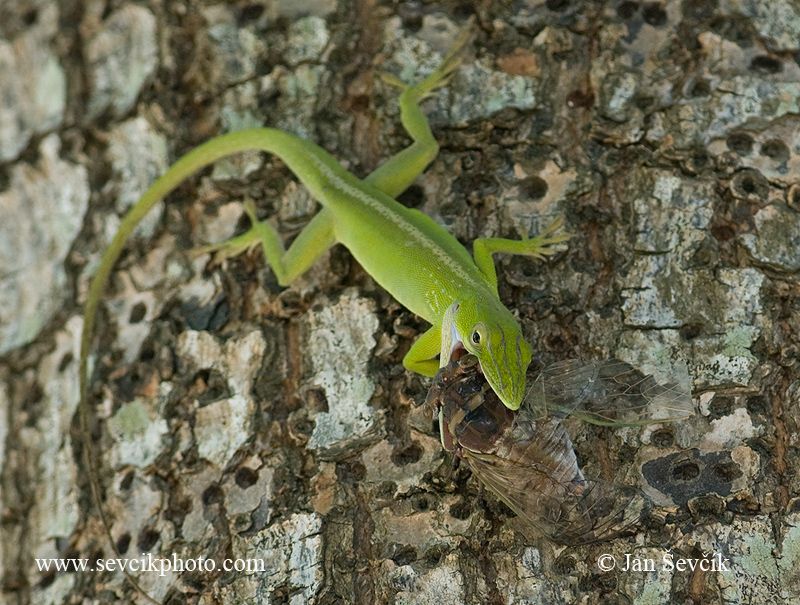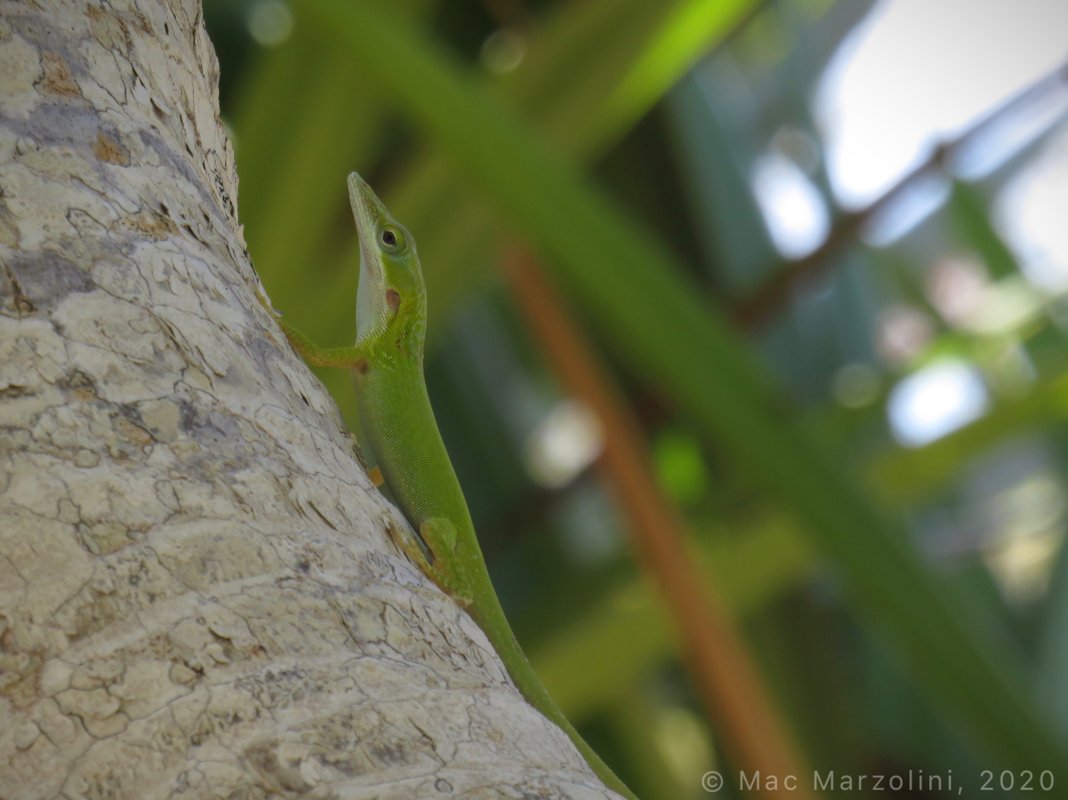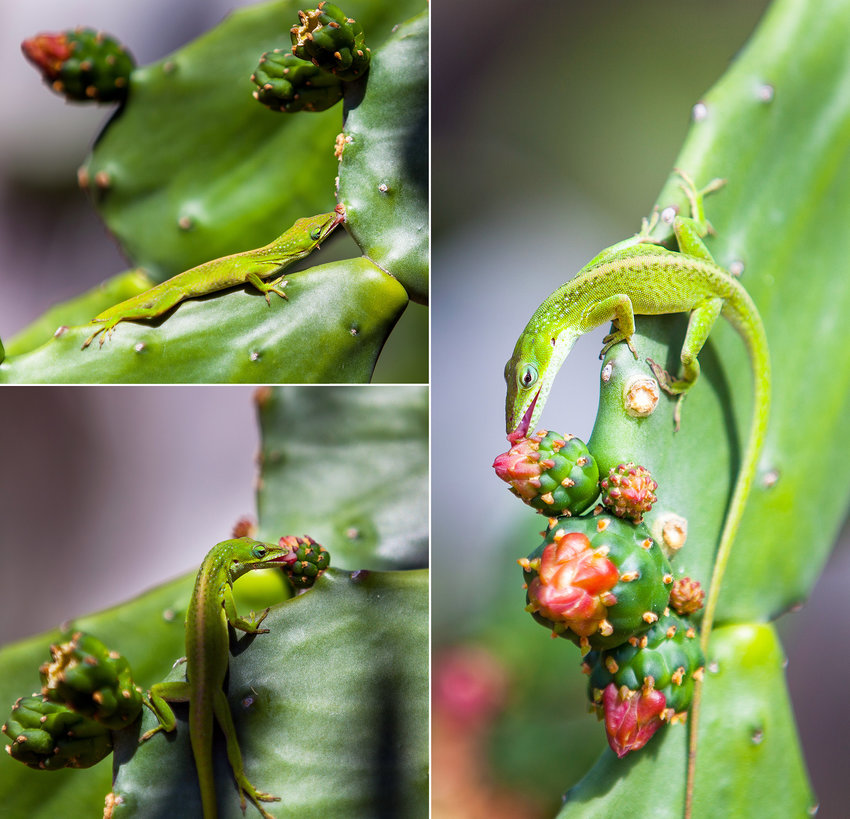
Two green lizards in Miami, one of each variety.
History is rich with great rivalries; David versus Goliath, Red Sox versus Yankees, Alien versus Predator, but one of the greatest match ups of our time is anole lizards versus gecko lizards. For readers of this blog that are unfamiliar, for which I assume there are few, geckos and anoles are well matched competitors because of their morphological and ecological similarities. Geckos (infraorder Gekkota) are the earliest branch on the squamate tree (sister to all other lizards and snakes) with over 1500 species around the globe, whereas anoles (genus Anolis) appeared roughly 150 million year after the origin of geckos (nested within the Iguania infraorder). The roughly 400 species of anoles can be found primarily in Central and South America. Geckos and anoles both independently evolved very similar hairy adhesive toe pads that help them adhere to and navigate vertical and inverted surfaces. While anoles can likely trace their toe pads to a single origin (and one loss in A. onca), toe pads likely arose and were lost multiple times within Gekkota, although we are still sorting out the exact details (Gamble et al., 2017). Nearly all anoles are arboreal and diurnal, with only a handful of terrestrial or rock dwelling species. Conversely, geckos can be found thriving in arboreal as well as rocky and terrestrial microhabitats day and night.
While anoles tend to get all of the attention from evolutionary ecologists, with decades of amazing research quantifying their habitat use in the Caribbean, geckos are actually older, with more ecological and morphological diversity. As my prior PhD advisor Luke Harmon can surely confirm, I have been interested in knowing how or if insights from Caribbean anole ecomorphology can be applied to geckos. How similar is the evolution and diversification of geckos and anoles? Do geckos partition their habitat along similar dimensions as Caribbean anoles?
In this post, I’d like to share some of my previous work comparing and contrasting gecko and anole diversification and habitat use and then solicit information and opinions from the anole community for an upcoming field trip in which we will be looking at habitat use of sympatric introduced geckos and anoles.

Fig 1. Our reconstruction of gecko (blue) and anole (green) ancestral toe pad performance based on our best fitting weak OU model of trait evolution. Horizontal bars below the X-axis represent the region in which we constrained the origin of toe pads for each clade. Detachment angle (y-axis) represents our measure toe pad performance (the maximum ratio of adhesion and friction a species can generate). The generation of more adhesion for a given amount of friction results in a higher detachment angle. Shaded bands represent our estimated OU optimum value for each clade. Figure modified from Hagey et al. (2017b).
In 2017, we had two great papers come out investigating the diversification of toe pad adhesive performance in geckos and anoles, and the ecomorphology of Queensland geckos. In our diversification paper (Hagey et al., 2017b), we found that while geckos are an older and larger group than anoles, their toe pad performance does not appear to be evolving towards a single evolutionary optimum. Instead, we found that Brownian motion with a trend (or a very weak Ornstein-Uhlenbeck model) best modeled our data, suggesting geckos have been slowly evolving more and more diverse performance capabilities since their origin approximately 200 million years ago (Fig 1). These results assume a single evolutionary origin of Gekkota toe pads, which was supported by our ancestral state reconstructions, but ancestral state reconstructions are far from a perfect way to infer the history of a trait. And so for now, the true history of the gecko toe pad’s origin(s) remains a ‘sticky’ issue. Conversely, adhesive performance in anoles appears to be pinned to a single optima in which anoles quickly reached after their split from their padless sister group (i.e. a strong Ornstein-Uhlenbeck model, Fig 1).
Given these results and the fact that geckos are such a morphologically diverse group, living on multiple continents in many different microhabitats, our results suggest the adhesive performance of geckos may be tracking multiple optima, and when pad-bearing geckos are considered together as a single large group, could produce the general drifting pattern we observed when we assume their ancestor started without little to very poor adhesive capabilities. On the flip side, we can imagine multiple reasons why anoles appear to be limited in their toe pad performance. Perhaps anoles lack the genetic diversity to produce more variable toe pads or they are mechanically or developmentally constrained to a limited area of performance space. Alternatively, since anoles are nearly all arboreal and diurnal in new world tropical environments, it is possible that they are all succeeding in the same adaptive zone and there isn’t the evolutionary pressure or opportunity to evolve more diverse performance capabilities. Closer studies of the adhesive performance capabilities of the few anoles species that have branched out from arboreal microhabitats, such as the rock dwelling aquatic species would be really interesting!

Fig 2. Our gecko and anole residual limb length calculations suggest geckos (grey triangles) generally have shorter limbs then anoles (black circles). Figure modified from Hagey et al. (2017a).
In our second paper from 2017 (Hagey et al., 2017a), we quantified microhabitat use and limb lengths of geckos across Queensland, Australia and compared these patterns to those known from Caribbean anoles. We found some interesting differences and similarities. Our first result arose as we tried to calculate residual limb lengths and realized that geckos, as a group, have shorter limbs than anoles, which resulted in us calculating residual limb lengths for geckos and anoles separately (Fig 2). We then compared microhabitat use and limb length patterns and found that Strophurus geckos may be similar to grass-bush anoles. Both groups have long limbs for their body lengths and use narrow perches close to the ground. We also found other general similarities such as large bodied canopy dwelling crown-giant anoles and large bodied canopy dwelling Pseudothecadactylus geckos. Unfortunately, we didn’t focus on sympatric Australian geckos and so we couldn’t make direct habitat partitioning comparisons to anoles. We hope to fix that in our next project and would really love to hear from you, the anole community.
Later this spring, I am planning a fieldtrip with John Phillips and Eben Gering, both fellow researchers here at Michigan State University, to Hawai’i (Kaua’i and O’ahu) to investigate habitat partitioning of invasive geckos and anoles, specifically A. carolinensis, A. sagrei, and Phelsuma laticauda. Jonathan Losos one claimed that Phelsuma are honorary anoles! These three species are all diurnal, arboreal, have adhesive toe pads, and are commonly seen in Hawai’i and so we expect them to be competing for perch space. This has been on some of the greatest anole minds since at least 2011 with Jonathan wondering which group would win when the two clades collide in the Pacific. Previous studies of anole ecomorphs across the Greater Antilles and invasive A. sageri in the southeastern US give us a good expectation of how the trunk-crown A. carolinensis and the trunk dwelling A. sagrei should interact and partition their arboreal microhabitat, with A. sagrei pushing A. carolinensis up the trunk. The wild card is P. laticauda. There hasn’t been much microhabitat use work done with Malagasy geckos, and definitely nothing compared to the extensive work with Caribbean anoles. As a result, I don’t know much about exactly what part of the arboreal environment P. laticauda uses in its natural range or how it will fit in with its new pad-bearing brethren in Hawai’i. The best information we have to my knowledge is a study of other arboreal Phelsuma by Luke Harmon in Mauritius (Harmon et al., 2007). He found that while the Phelsuma geckos of Mauritius also partition their arboreal habitat by perch height and somewhat by diameter, they also partition by palm-like or non-palm-like perches. I’m not aware of any anole observations suggesting a palm/non-palm axis of partitioning and so this may be a novel axis that P. laticauda is using in Hawai’i to live in amongst the anoles.
Anoles, geckos, and Hawai’i have come up repeatedly here on Anole Annals
Reproductive Biology of Introduced Green Anoles in Hawaii
JMIH 2016: Anolis vs. Phelsuma in Hawaii
Amazing Green Anole Battle In Hawaii
More On Anoles And Day Geckos In Hawaii
Anoles And Banana Flowers In Hawaii
Fighting Hawaiian Anoles
Brown Anoles on Hawaii and Battle of the Intercontinental Convergents
Many Hawaiians Don’t Like Brown Anoles
SICB 2018: Unraveling Natural and Human-Mediated Founder Events in Anolis carolinensis
Factors Restricting Range Expansion for the Invasive Green Anole Anolis carolinensis on Okinawa Island, Japan
Anole Watercolor Available on Etsy
A Failed Anole Predation Attempt
This Is Not A Madagascan Day Gecko
Battle of the Diurnal, Arboreal Exotics in Florida (the Anole Loses)
Strange perch mate
Green Anole Mayhem
and so we know folks have been thinking about these species and specifically this invasive set of species for a while. We are especially excited to see Amber Wright’s research suggesting P. laticauda was perching above A. carolinensis in her enclosures. We want to know what the anole community has to say. We also don’t want to duplicate or intrude on any projects that are already under way.. If this is something you’ve already started, or started to wonder about… let us know! We would love to collaborate, partitioning interesting questions, if there are already labs working in this arena. We would also be grateful for suggestions, field site recommendations, or relevant publications we may have missed.















